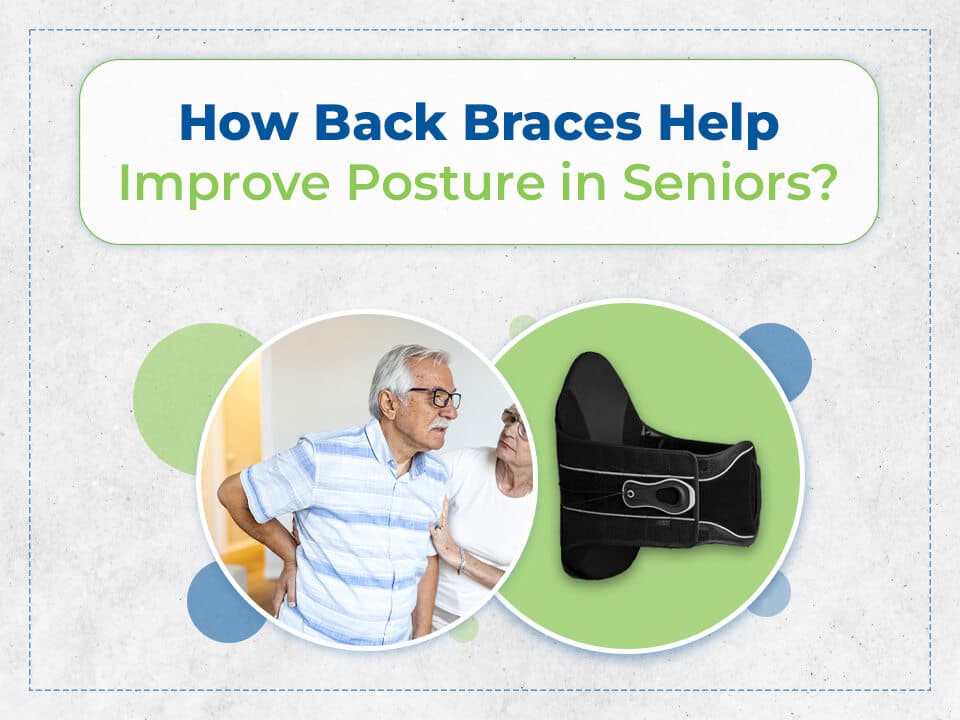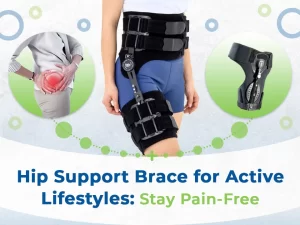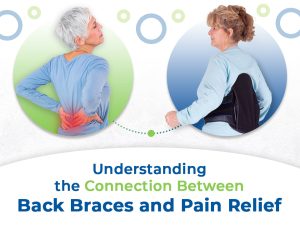As we age, our bodies undergo various changes that can impact our posture and overall health. Poor posture can lead to a variety of health problems, including back pain, muscle weakness, and decreased mobility. However, seniors can improve their posture and overall health by using back braces. In this article, we’ll explore how back braces can help seniors improve their posture, the benefits of using them, and how to choose the right one. We’ll also provide tips on wearing back braces and other tools that seniors can use to enhance their posture and well-being.
Why Back Braces Can Help Improve Posture
Up to 80% of people suffer from back pain at some point. For many, this pain goes away by itself, but others develop a chronic condition that can impact everyday living. Seniors are at an increased risk of poor posture due to various factors, including weakened muscles, arthritis, and osteoporosis. Weak muscles can lead to poor posture, while arthritis and osteoporosis can cause pain and limit mobility, which can also impact posture. Poor posture can lead to a host of health problems, such as back pain, muscle weakness, and decreased mobility.
Back braces can help improve posture in seniors by providing support and reducing pain. The braces work by applying pressure to the spine, which helps to align the back and shoulders properly. This reduces the strain on the muscles, ligaments, and joints, which can help to alleviate pain and improve posture.
There is evidence-based research that supports the effectiveness of back braces in improving posture. A study published in the Journal of Back and Musculoskeletal Rehabilitation found that wearing a back brace for 4 weeks led to significant improvements in posture and pain reduction among seniors with spinal curvature. Another study published in the Journal of Physical Therapy Science found that back braces improved posture and reduced pain among seniors with osteoporosis.
Back braces can help seniors improve their posture by providing support and reducing pain. Research has shown that they can be an effective tool for improving posture and overall health. In the next section, we’ll discuss how to choose the right back brace for your needs.
Choosing the Right Back Brace
When it comes to choosing the right back brace, there are different types available for seniors, including soft, rigid, and semi-rigid braces.
Soft back braces are made of flexible materials, such as neoprene, and are designed to provide light support and compression. They are often used for minor back pain and to prevent further injury. Rigid back braces are made of hard plastic or metal and provide more support and immobilization. They are often used for more severe back injuries or after surgery. Semi-rigid back braces are a combination of soft and rigid materials, providing a balance of support and comfort.
Each type of back brace has its advantages, and seniors should consider their individual needs and preferences when choosing a back brace. Soft back braces are lightweight and comfortable to wear but may not provide enough support for more severe back problems. Rigid back braces offer maximum support and are effective for severe back injuries but can be uncomfortable to wear for extended periods. Semi-rigid back braces offer a balance of support and comfort but may not be as effective for severe back problems.
To choose the right back brace, seniors should consult with a healthcare professional, such as a physical therapist or orthopedic specialist. These professionals can assess their individual needs and recommend the best type of back brace for their specific condition. It’s also important to consider factors such as comfort, fit, and adjustability when choosing a back brace. Seniors should try on different types of back braces to find the one that feels the most comfortable and provides the right amount of support.
Our back braces feature adjustable compression systems and are available for lower and mid-back support. Our back braces or orthoses can help with conditions such as:
- Disc degeneration
- Sprains and strains
- Spinal stenosis
- Lumbago
- Lumbar disc displacement
- Scoliosis
- Muscular weakness
- Fibromyalgia
- Post-surgery spinal stabilization and more.
If you’re not sure what product is right for you or if you’re eligible for insurance coverage, Artik Medical Supply will provide the guidance you need. We can even communicate with your doctor to determine the best back brace for you. Contact us today for a free insurance coverage review.
In the next section, we’ll offer tips on how to wear back braces correctly for maximum effectiveness and comfort.
Best Practices for Wearing Back Braces

To ensure maximum effectiveness and comfort when wearing back braces, seniors should follow some best practices.
First, it’s important to wear the back brace correctly. The brace should fit snugly but not be too tight and should be positioned properly on the back. Seniors should follow the instructions provided by the manufacturer and/or their healthcare professional for proper placement and adjustment.
Back braces should be worn for a limited amount of time each day. This varies depending on the type of brace and the individual’s condition, but generally, back braces should be worn for no more than 4-6 hours per day. Wearing a back brace for too long can lead to muscle weakness and dependency on the brace.
Seniors should also be mindful of their posture when wearing a back brace. The brace is designed to provide support, but it’s important to maintain good posture as well. This means sitting and standing up straight, with the shoulders back and the head aligned with the spine.
Common concerns and questions about wearing back braces include whether they are safe and if they can be worn during exercise. Back braces are generally safe when used properly, but seniors should consult with their healthcare professional before using one. They can also be worn during exercise, but again, seniors should consult with their healthcare professionals to ensure proper use.
Back braces can be very effective for improving posture and reducing pain in seniors. By choosing the right type of back brace, wearing it correctly, and following best practices for use, seniors can improve their posture and overall health.
Read More: What Does Medicare Cover for Back Braces?
Other Posture Correction Ideas for Seniors
While back braces can be effective for improving posture, there are additional things to consider that can help seniors achieve better posture and overall health.
Physical therapy is one. A physical therapist can work with seniors to develop a personalized exercise and stretching program that targets specific muscle groups and helps improve posture. This can also help reduce pain and stiffness in the back, neck, and shoulders.
Exercise is another important one for improving posture. Activities such as walking, swimming, and yoga can help strengthen the muscles that support good posture. Seniors should consult with their healthcare professionals before beginning an exercise program to ensure it’s safe for their individual needs and condition.
Ergonomic furniture is also important for maintaining good posture. This includes chairs, desks, and other equipment that are designed to support the back and promote good posture. Seniors should look for chairs with good lumbar support, adjustable height, and desks that can be raised or lowered to the correct height for comfortable and ergonomic use.
When used in combination with back braces, these can help seniors achieve better posture and overall health. Seniors should consult with their healthcare professionals to develop a comprehensive plan for improving posture that includes the use of back braces and other treatments as appropriate.
In Conclusion
Back braces can be an effective tool for improving posture in seniors. By choosing the right type of back brace, wearing it correctly, and following best practices for use, seniors can improve their posture and overall health. Other things, such as physical therapy, exercise, and ergonomic furniture, can also complement the use of back braces in achieving better posture and overall health. Seniors should consult with their healthcare professionals to develop a comprehensive plan for improving posture that meets their individual needs and preferences.
Are you in need of pain relief or recovering from an injury or surgery? Connect with us today to check eligibility and see how we can help.
Article Key Phrases
- Types of back braces for seniors.
- How back braces improve posture.
- Posture improvement in seniors.
- Benefits of back braces for posture.
- Back braces for seniors.







